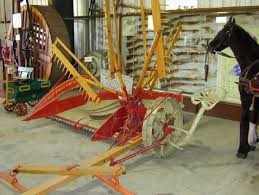Early Sail Reapers that Cut Grain Before the Grain Binders
Whitewater News Country Living column May 26
Rare “Sail Reaper” Highlight of Agricultural Museum
By Maynard van der Galien
If you think you’ve seen it all when it comes to antique farm machinery and pioneer collection items, you haven’t been to the B.C. Farm Machinery and Agricultural Museum in the Fraser Valley. It is one of the largest pioneer museums in Canada.
I love nosing around in museums and on a recent visit to British Columbia I visited three museums. The day a friend took me to the Farm Museum in Fort Langley, we were given a grand tour of the place.
When we arrived at the lower level, we met a dozen retired mechanics, machinists and millwrights who volunteer their time every Monday restoring old vehicles and machinery. The man in charge of the restoration work was a big fellow with a Dutch name (Hans) and an accent. I greeted him in Dutch and asked him what year he immigrated. He was impressed that I had no accent and still able to speak Dutch.
Hans gave us a complete tour of the building, a former factory. Some artifacts are always locked away. At one point, he said, “Get your camera out again because I’m going to show you something you’ve never seen before.”
In front of me at eye level was a (stuffed) two-headed Hereford calf – a red body with two white faces. The calf was born on a farm in Brooks, Alberta in 1980 and lived three weeks. It was a big sized calf.
Other highlights in the museum included B.C.’s first crop dusting, 1941 vintage Tiger Moth airplane; a 1919 Model T milk truck used now in parades; and a Coleman High Cut Plow, which I had never seen before. They were built to cut a deep furrow – probably black mucky ground.
There were many makes and models of antique tractors. An Avery 1920 model C-6, 6-12 hp tractor was the first one to have power steering. It has a shaft gear in front of the hood going to the front wheels.
My biggest surprise was seeing a Sail Reaper –an early grain binder from the mid-1800s — in mint condition. Revolving wooden rakes, like paddlewheels, swept cut grain onto a platform from which a man walking alongside raked it off into piles. The machine could harvest more grain than five men using the earlier cradles. The 1967 movie Far from the Maddening Crowd, starring Julie Christie and Peter Finch, shows grain being harvested with the early model Sail Reapers. Those machines were noisy and made clanking sounds.
I found that curators I spoke with in Ontario museums I visited had never heard of the Sail Reapers.
Grain-harvesting technology has made spectacular progress, especially when you consider that a few farmers were still cutting grain by hand and flailing it in the barn as late as the 1860s, a method that produced fewer than eight bushels of grain per day.
A man walked behind the early reapers holding the reins of the horses, but later reapers allowed the driver to sit on the machine, saving his weary feet and allowing more working time.
The B.C. museum tour was like a walk through the past. If you get the chance, this agricultural museum is well worth your time.







![Kenopic/Smith Auction [Paid Ad]](https://whitewaternews.ca/wp-content/uploads/2018/10/advertising-100x75.jpeg)

